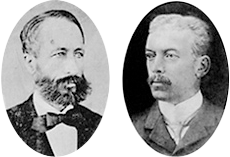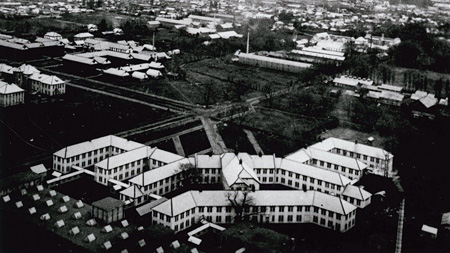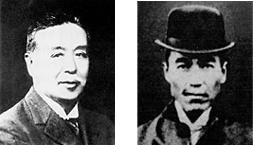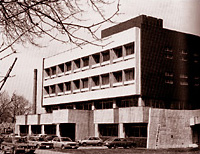History
Frontier spirit to explore practical sciences and the unknown world
In the early Meiji era, the development of Hokkaido was essential for the establishment of Japan as a modern nation. Sapporo Agricultural College (later Hokkaido University) was established for the purpose of fostering human resources for the development of Hokkaido.
At Sapporo Agricultural College, William Smith Clark, William Wheeler and other American teachers introduced a new learning method based on nature observation and the spirit of scientific research, different from the conventional Japanese teaching method. They were as much excellent engineers as teachers. Some of the students, who learned practical sciences and the frontier spirit from them, became leaders of modern Japanese society, technology and education.
The tradition and spirit of Hokkaido University's education, characterized by unlimited ideas, experimental minds and empirical approaches with an emphasis on fieldwork, were formed there.


Beginning of electrical and electronic engineering in Hokkaido
The field of engineering at Hokkaido University started with the opening of the Department of Engineering of the Sapporo Agricultural College in 1887. It was opened by world authority on bridge engineering Isamu Hiroi (a second-year graduate of the College), and its first-year students included Bunkichi Okazaki, who established the river improvement theory that is still applicable to the present day. The Department of Engineering was, however, closed in its tenth year. Later, in 1924, Hokkaido Imperial University established the Department of Engineering and inaugurated a course of electromechanical engineering.
The foundation of the present Graduate School of Information Science and Technology was formed with the creation of a new university system after the end of World War II.
The Division of Electrical Engineering was opened in the Graduate School of Engineering, followed by the establishment of the Division of Precision Engineering in 1962 and the Division of Electronic Engineering in 1964. With the reorganization of the Research Institute of Ultrashort Waves established in prewar days into the Research Institute of Applied Electricity (currently the Research Institute for Electronic Science), research and education systems for electrical and electronic engineering were also realized, producing many leading figures in Japanese information technology.


Evolution of information electronics
Japan's electronic engineering made great strides forward with the postwar evolution of computers.
The Large-Scale Computer Center was opened in Hokkaido University in 1970, as one of the seven universities (old Imperial Universities) throughout Japan, and the FACOM230-60 system was introduced. The network connecting these Large-Scale Computer Centers later became the backbone of Japan's Internet community, and the role played by Hokkaido University in it was quite significant.
In the 1970s, the number of information science divisions increased to five with the establishment of two new ones - the Divisions of Information Engineering and Biomedical Engineering.
Unlike the relatively slow progress of informatization in the 1960s and 1970s, the dramatic information revolution from the 1980s onward had various impacts on the University's research content and systems. In particular, the IT revolution and university reform movement in the 1990s led to the reorganization of information-related divisions.
In our education and research systems, the previous structure was reorganized into the Divisions of Systems and Information Engineering and Electronic and Information Engineering, with increased emphasis on the importance of graduate education in 1995. In 2001, the Research Center for Integrated Quantum Electronics was established. In 2003, the Large-Scale Computer Center and Center for Information and Multimedia Studies were integrated into the Information Initiative Center. In 2004, information-science-related divisions of the Graduate School of Engineering were abolished, and the Graduate School of Information Science and Technology was newly established.


Together with the introduction of the ultrasmart societies
In the 2010s, physical space (real space) and cyber space (virtual space) joined together synergistically as a result of advances in technologies such as AI, IoT, big data analysis, and robotics. This integration has reached all domains of society, and is creating great social value, leading to the introduction of ultrasmart societies. At Hokkaido University, to foster data science human resources, who are overwhelmingly demanded by society today, in 2017 the Education and Research Center for Mathematical and Data Science was founded as a Common Facility on Campus (educational facility). In addition, to support new interdisciplinary education integrating information science and a variety of other academic fields, in 2019 the Graduate School of Information Science and Technology was separated into a research organization (Faculty of Information Science and Technology) and an educational organization (Graduate School of Information Science and Technology). Accompanying this move, the Division of Information Science and Technology was established as a division with five courses in the School of Information Science and Technology.
The Graduate School of Information Science and Technology leads the promotion of research and development of human resources for the continued innovation of science and technology, which form the basis of information society. Its presence is based on the academic climate of Hokkaido University, which has opened new frontiers with its unlimited ideas and experimental spirit.
Chronological Table
| 1876 | Sapporo Agricultural College was established. |
|---|---|
| 1918 | Hokkaido Imperial University was established. |
| 1924 | The Faculty of Engineering was established. |
| 1925 | Department of Electrical Engineering was established. |
| 1947 | Hokkaido Imperial University was renamed Hokkaido University. |
| 1949 | In accordance with the National School Establishment Law, Hokkaido University was established. |
| 1953 | The Graduate School of Engineering was established under the new system. Division of Electrical Engineering was established. |
| 1958 | Department of Precision Engineering was established. |
| 1960 | Department of Electronic Engineering was established. |
| 1962 | Division of Precision Engineering was established. |
| 1964 | Division of Electronic Engineering was established. |
| 1973 | Division of Information Engineering was established. |
| 1979 | Division of Biomedical Engineering was established. |
| 1987 | Department of Information Engineering was established. |
| 1992 | Research Institute for Electronic Science was established. |
| 1995 | Divisions of Precision Engineering, Electrical Engineering, Information Engineering, Electronic Engineering and Biomedical Engineering were reorganized as Divisions of Systems and Information Engineering and Electronic and Information Engineering. Departments of Precision Engineering, Electrical Engineering, Information Engineering and Electronic Engineering were reorganized as Departments of Information Engineering, Electronics Engineering and Systems Engineering. |
| 2001 | Research Center for Integrated Quantum Electronics was established. |
| 2003 | Information Initiative Center was established. |
| 2004 |
Divisions of Systems and Information Engineering and
Electronics and Information Engineering were abolished,
and the Graduate School of Information Science and
Technology was established. Six divisions—Division of Synergetic Information Science, Division of Computer Science, Division of Electronics for Informatics, Division of Bioengineering and Bioinformatics, Division of Media and Network Technologies, and Division of Systems Science and Informatics—were established in the Graduate School of Information Science and Technology. |
| 2014 | The Division of Synergetic Information Science and Division of Computer Science were reorganized into the Division of Computer Science and Information Technology. |
| 2016 | The Global Station for Big Data and Cybersecurity of the Global Institution for Collaborative Research and Education (GI-CoRE) was established in the operated as an organization under the direct control of the President of Hokkaido University. |
| 2017 | The Education and Research Center for Mathematical and Data Science was established as a Common Education and Research Facility on Campus. |
| 2019 |
The Graduate School of Information Science and
Technology was reorganized, resulting in the
establishment of the Faculty of Information Science and
Technology (research organization) and Graduate School
of Information Science and Technology (educational
organization). Five departments were established in the Faculty of Information Science and Technology: Department of Computer Science Information Engineering,Department of Electronics for Informatics, Department of Bioengineering and Bioinformatics, Department of Media and Network Technologies, and Department of System Science and Informatics. The Division of Information Science and Technology was established in the Graduate School of Information Science and Technology. This division consists of five courses: Course of Computer Science and Information Technology, Course of Electronics for Informatics, Course of Bioengineering and Bioinformatics, Course of Media and Network Technologies, and Course of Systems Science and Informatics. |
| 2021 | The Global Station for Big Data and Cybersecurity of the Global Institution for Collaborative Research and Education (GI-CoRE) the GSB has transitioned into the Collaborative Center for Big data and IoT (CCB) which was established in the Faculty of Information Science and Technology. |
